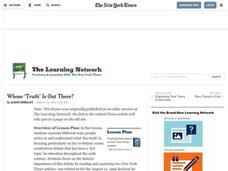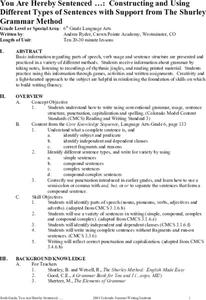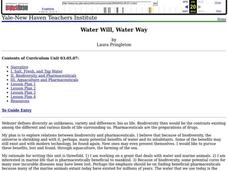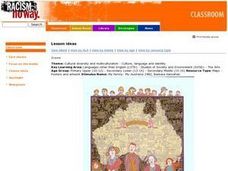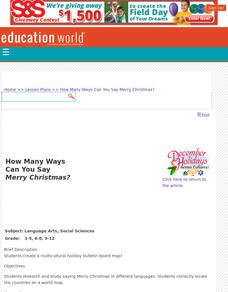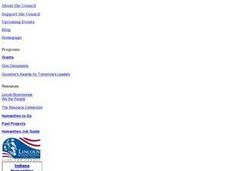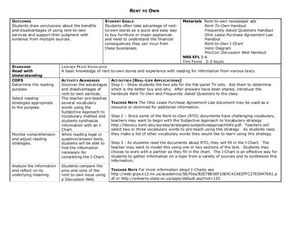Curated OER
Whose "Truth" Is Out There?
Young scholars read article It's a Fact: Faith and Theory Collide Over Evolution, and examine different ways people arrive at what 'the truth' is, focusing on the evolution vs creationism debate that has been a hot topic throughout the...
Curated OER
Angling Your Way Through a Picture
Students look at the geometry in an artwork. In this art history/geometry lesson, students research the artist Charles Sheeler and look at his painting Stacks in Celebration. They find the different types of lines, angles, and...
Curated OER
Species Diversity in Ecosystems with Different Techniques of Land Management
Students visit numerous places to help in their understanding of Ecology. In this biology lesson plan, students will learn about characteristics and how to identify numerous plants and animals. This lesson allows for many field trip...
Curated OER
Where Is Japan? How Are We Alike And Different?
First graders use literature, maps, and globes to explain how physical environments in various parts of the world are similar to and different from one's own, and that certain areas have common characteristics and can be called regions.
Curated OER
Tourism Potential in Different Locations
Students research an underdeveloped area and discuss ways that tourism could be promoted in that area. They work collaboratively to create a proposal for the rest of their group to encourage an investment in their selected region. They...
Curated OER
Poke and Look Learning Books
Learners read Poke and Look Learning Books and complete predicting activities, reading, questioning, and more. In this Poke and Look Learning Books, students do this for 13 different books.
Curated OER
Early American Portraits: a Strategy for Learning About Artists and Their Works
Students study artworks from several different artists. They compare and contrast these works and examine the historical background of the artist and his or her times.
They develop the capacity to think critically and communicate their...
Curated OER
Plant and Animal Cells - Are they Different?
Students observe the similarities and differences between plant and animal cells. In this cell activity, students use microscopes to observe self prepared slides of animal and plant cells.
Curated OER
Learning About Watersheds
In this learning about watersheds worksheet, students answer 15 questions using links to web resources about water use in their community. This page includes numerous links to helpful websites.
Curated OER
Constructing and Using Different Types of Sentences with Support from The Shurley Grammar Method
Students analyze parts of speech, sentence structure, and ver usage in this ten lesson unit on grammar. Through games, activities, assignments, and printed material, the concepts are supported and reinforced in a creative way.
Curated OER
Personal Learning Profile Project
Students take notes on a prepared advanced organizer. They analyze dreams and goals across many parts of life and create different types (paths) of goals to accomplish dreams. They classify dreams and goals generated across these ...
Curated OER
Water Will, Water Way
Young scholars test tap water for hardness and mineral content. In this environmental science instructional activity, students identify the different stages of the water cycle. They classify plant and animals according to the rules of...
Curated OER
ALIKE, DIFFERENT, OR BOTH?
Students compare and contrast two characters from the play The Diary of Anne Frank on a Venn diagram and write a paragraph showing similarities and differences.
Curated OER
Racism No Way
Learners explore different cultural influences and their contribution to Australian identities. They reflect on their own backgrounds and making links with their peers, reflect on our heritage. Students view My family- My Australia,...
Curated OER
How Many Ways Can You Say Merry Christmas?
Students create a multicultural holiday bulletin board map! students research and study saying Merry Christmas in different languages. They correctly locate the countries on a world map.
Curated OER
Post Civil Way Reconstruction
Eleventh graders research different documents pertaining to the reconstruction era. They present their findings to the class in structured presentations and unstructured discussions. Students compare and contrast their findings about...
Curated OER
Learning the Causes of Extinction
Students are introduced to the five major reasons for extinction. In groups, they read scenarios and divide them into different categories. Using the internet, they identify which reason a certain animal became extinct. To end the...
Curated OER
Math Shortcuts
Looking for a different way to introduce long division? Need a shortcut for checking multiplication answers? Then this is for you! The multiplication method uses a quick trick to check for accuracy. The division method allows learners to...
Curated OER
Hermeneutics: Teaching Students Author's Purpose
Your developing literary critics discuss 'perspective' and discuss how the same occurence can be interpreted by two different people in two different ways. They read Ryszard Kapuscinski's untitled poem, infer meaning of the poem, and...
Curated OER
Magnets are forceful
You could use this worksheet two different ways. As is, or you could have learners actually do the experiment shown. They are to determine which magnet is strongest by counting the number of paper clips hanging from it. Why not get five...
Curated OER
Telling Time as an Everyday Use of Numbers
How can we estimate time? Have your young mathematicians make a clock. Then they compare and contrast types of clocks. They practice writing times in two different ways and make a book about telling time.
Curated OER
Ending a Famous Fairy Tale
Altering the ending of a famous fairy tale is a really fun way for kids to experience creative writing. The lesson here has them do just that! Learners listen to the famous fairy tale, "The Twelve Brothers," and change the ending of the...
Curated OER
Rent To Own
Reading can be a good way to learn about many different things, like rent-to-own housing programs. Learners read informational resources about rent-to-own programs and how they work. They complete graphic organizers using the facts they...
Curated OER
Food for thought
Cake has to be good for something, right? Different foods are used by our bodies in different ways. Learners will first read about what fats, proteins, fruits, and vegetables do for the human body. They will then put each of food shown...
